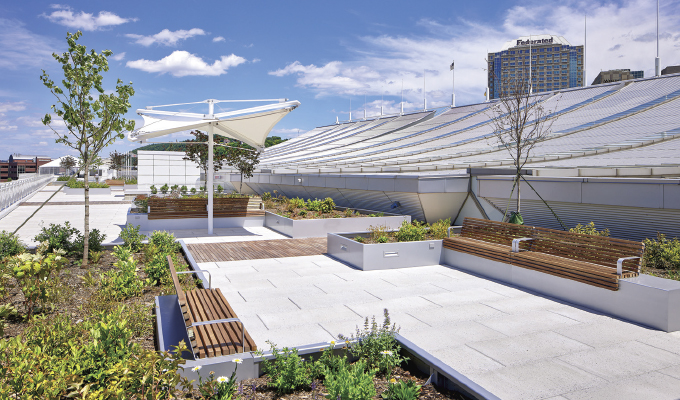As cities across North America grapple with upticks in climate events that are becoming increasingly devastating, the need for resilient urban infrastructure has never been greater. From record-breaking storms to rising temperatures, the built environment must evolve to withstand and adapt to these challenges.
Intensifying storms put immense environmental and economic strain on municipalities. With heavy rainfall that can overwhelm drainage systems and lead to flooding, and rising temperatures that exacerbate the urban heat island, cities must rethink traditional development models and integrate climate-adaptive solutions into their long-term planning.
For building owners who are looking ahead to proactively mitigate these symptoms, vegetated roofs, or green roofs, offer a promising solution. These engineered vegetative systems help manage stormwater runoff, promote sustainability, and enhance long-term urban resilience. Beyond pure aesthetics, vegetated roofs play a critical role in stormwater management, heat mitigation, and air quality improvement.
BASICS OF CONSTRUCTION
Strategically designed to mimic the effects of natural landscapes, vegetated roof systems are designed with multiple layers, each of which serves a specific purpose. First, a membrane keeps the structure watertight, protecting the building. A root barrier is responsible for resisting root penetration of the membrane layer, which may not be necessary with all membrane technologies. A drainage and retention layer provides drainage and retains water for use by the plant material, which also provides aeration to the bottom of the media profile.
The top layer is comprised of specialized soil that includes coarse aggregates, fine aggregates, and organic components that make up the growing media with water and nutrient-holding capacity. A majority of the retention capacity of a vegetated roof is within the profile of the media. Lastly, vegetation is added to absorb water and release it back into the atmosphere through evapotranspiration, integrating natural water cycles.
Compared with at-grade landscapes, vegetated roofs are beneficial because stormwater cannot infiltrate the groundwater, which is especially significant as many municipalities are now implementing detention-based requirements that require water to be captured and held on-site for a duration of time and slowly released to the storm. However, there is a finite amount of water that vegetated roofs can retain before the roof will start to release the water down a drain and away from the project.
WHAT BUILDERS NEED TO KNOW
Proper installation and coordination with roofing professionals are essential to ensure longevity and performance, which is one of the key benefits of vegetated roofs as a viable and lasting investment in sustainable development. The initial investment into vegetated roof systems offers long-term financial and environmental benefits including reduced energy expenses, extended roof lifespan, minimized stormwater fees, and increased property value. Additionally, cities investing in green roof incentives and stormwater credits are making adoption more feasible for building owners and developers.
Advancements in materials and design have also made vegetated roofs viable in a wide range of climates and building types. Proper plant selection—from sedums and succulents to large, mature trees—and irrigation systems ensure adaptability across commercial buildings for various needs.
WHY BUILDING OWNERS SHOULD CARE
Urban environments typically lack sufficient amounts of green landscapes that naturally absorb and retain water, which makes stormwater runoff a large problem for municipalities. Unlike traditional rooftops, which contribute to rapid stormwater runoff, green roofs absorb and retain rainwater within their soil layers. This reduces the burden on city drainage systems, mitigating flood risks and preventing pollutants from entering waterways.
Furthermore, vegetated roofs can help mitigate the heat-island effect—where urban areas are, on average, 2 to 5 degrees warmer than surrounding rural areas due to materials that absorb and hold heat and lack sufficient plant cover. Green roofs can help lower temperatures through evapotranspiration, a natural phenomenon wherein plants release moisture into the atmosphere. This cooling effect reduces the need for air conditioning, cutting energy consumption and decreasing greenhouse gas emissions.
Vegetated roofs can also improve air quality by incorporating vegetation which filters pollutants and noxious gases and reduces carbon dioxide levels. By creating habitats for pollinators and other wildlife, green roofs contribute to the biodiversity of the region which is essential for healthy ecosystems.
Overall, vegetated roofing represents a vital strategy for managing stormwater while building for a resilient, efficient, and environmentally conscious future.

about the author
Rick Kile, director of green and amenity business at Siplast, brings extensive experience in the construction industry and developed a strong foundation in urban design and comprehensive planning. His expertise lies in fostering innovative solutions that enhance both environmental sustainability and aesthetic appeal. Rick’s passion for creating functional, green spaces has positioned him as a key player in advancing Siplast’s commitment to sustainable construction practices. For more, visit www.siplast.com.


